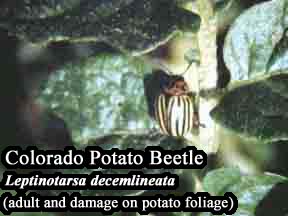Eggplant (Solanum)
Plant Health Problems
Diseases caused by Fungi:
Verticillium wilt, Verticillium dahliae.
The first symptom of eggplants infected with wilt is stunted
growth followed by the wilting of leaves during the heat of the
day. These leaves recover as the day cools. When the first fruit
is set, certain leaves exhibit angular interveinal chlorosis or
yellowing. Often half of a leaf becomes yellow and wilted.
Finally, these leaves wither and fall off. The diseased plant is
usually stunted and heavily defoliated. The inside of the stem is
discolored. Verticillium, the fungus which causes this
disease, can be seedborne and may live in the soil for many
years. The fungus attacks a great number of other plants,
including potatoes, tomatoes, snapdragons, and maples.
The only way to totally avoid the disease is to use clean seed,
and plant on soil with no history of Verticillium wilt. However,
the use of black plastic mulch and soil compost amendment may
reduce the damage done by this disease.
Phomopsis blight, Phomopsis vexans.
This disease shows as light-colored leaf spots, and as a light
brown spot rot on the fruit. Young plants may be killed outright.
Infected fruits may rot completely. The fungus which causes this
disease is soil- and seedborne. The spread of the disease is
favored by warm, wet weather.
Use clean, properly treated seed and a four-year crop rotation.
The spread of this pathogen can be reduced through the use of
mulch which reduces the amount of soil splashed onto fruit and
foliage during rain.
Insect Problems:
 Colorado potato
beetle.
Colorado potato
beetle.
This beetle in both the larval and adult stages feeds upon
eggplant. See
Colorado Potato Beetle fact sheet.
Cutworms.
See
Cutworm fact sheet.
Flea beetles.
The eggplant flea beetle, Eptrix fuscula, and the potato
flea beetle, Epitrix cucumeris, feed on eggplant.
See Flea
Beetle fact sheet.
Hornworms.
The tobacco and the tomato hornworms both occur in Connecticut
and occasionally feed upon eggplant.
The tobacco hornworm, Manduca quinquemaculata
larvae and that of the tomato hornworm, often feed upon the
leaves of flowering tobacco. When fully grown, this larva is
about 4" long, green with oblique whitish bands along each
side and a horn on the tail end of the body. The adult moth is
similar to that of the tobacco worm except that the forewings
have a mottled gray-brown, appearance, and are somewhat darker in
color. The wing spread is between 4 and 5". Although these
caterpillars become large and consume a substantial quantity of
leaf material, they are rarely abundant enough to require more
than handpicking in gardens. Their abundant natural enemies
usually regulate the population. Among the compounds registered
for control of this pest in Connecticut are Bacillus
thuringiensis var. kurstaki (Bt) or rotenone, which
must be used when larvae are still small. Handpicking is more
effective in gardens when the larvae are larger and more obvious.
Consult the label for dosage rates, safety precautions, and
preharvest intervals. The tomato hornworm, Manduca
quinquemaculata, often feeds upon the leaves of tomato. When
fully grown, this larva is about 4" long, green with oblique
whitish bands along each side and a horn on the tail end of the
body. The adult moth is similar to that of the tobacco worm
except that the forewings have a mottled gray-brown, appearance,
and are somewhat darker in color. The wing spread is between 4
and 5". Although these caterpillars become large and consume
a substantial quantity of leaf material, they are rarely abundant
enough to require more than handpicking on tomato in gardens.
They do not usually feed directly on the fruit, and their
abundant natural enemies usually regulate the population. Among
the compounds registered for control of this pest in Connecticut
are Bacillus thuringiensis var. kurstaki (Bt) or
rotenone, which must be used when larvae are still small.
Handpicking is more effective in gardens when the larvae are
larger and more obvious. Consult the label for dosage rates,
safety precautions, and preharvest intervals.
Pepper maggot, Zonosemata electa.
These maggots may also feed in the fruits of eggplant. The
maggots of these barred-wing flies infest the fruits of peppers,
causing them to decay, and in eggplants, resulting in tunneling
within the fruit. The eggs are deposited in late July and August
in the wall of the fruit and often project into the interior
cavity. They hatch in 10 days and feed inside the core until
mature, a period varying from 12 to 22 days. They then make an
exit, usually near the stem in peppers, and go into the ground
and pupate 1 or 2" beneath the surface. There is one
generation a year. The adult fly is light yellowish-brown in
color, with three brown bands across each wing. The adults feed
on nitrogenous materials (perhaps bird droppings) in trees near
pepper or eggplant fields. Damaging infestations are patchy and
sporadic in Connecticut, and limited to fruit developing during
the brief period (2-3 weeks) when egg-laying occurs. The problem
is not usually recognized by the gardener until it is too late
for control.
Potato aphid, Macrosiphum euphorbiae.
This aphid sometimes feeds on eggplant.
See Aphid
fact sheet.

